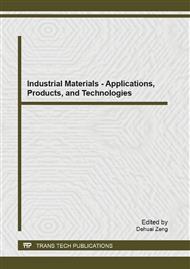[1]
Z.Y. Chen, C.L. Tang, J. Fu, X. Jiang, Q.Q. Li, L.J. Wei, Z.H. Huang, Experimental and numerical investigation on diluted DME flames: Thermal and chemical kinetic effects on laminar flame speeds, Fuel 102 (2012) 567-573.
DOI: 10.1016/j.fuel.2012.06.003
Google Scholar
[2]
M.C. Lee, Y.B. Yoon, Development of a gas turbine fuel nozzle for DME and a design method thereof, Fuel 102 (2012) 823–830.
DOI: 10.1016/j.fuel.2012.05.017
Google Scholar
[3]
K. Photinon, S.H. Wang, C.C. Liu, Development of a dimethyl ether sensor using platinum nanoparticles and thick-film printing, Biosens. Bioelectron. 22 (2006) 501-505.
DOI: 10.1016/j.bios.2006.07.001
Google Scholar
[4]
K.W. Zhou, X.R. Zhang, Determination of butanone in workshop air utilizing chemiluminescence on nanosized materials, Chin. J. Anal. Chem. 32 (2004) 25-28.
Google Scholar
[5]
K.W. Zhou, Y.X. Zhao, Z. Xu,Y. Tong, Determination of BTX in air utilizing cataluminescence on nanometer composite materials, Chin. J. Anal. Lab. 25 (2006) 13-16.
Google Scholar
[6]
K.W. Zhou, X.L. Ji, N. Zhang, X.R. Zhang, On-line monitoring of formaldehyde in air by cataluminescence-based gas sensor, Sens. Actuators B 119 (2006) 392-397.
DOI: 10.1016/j.snb.2005.12.038
Google Scholar
[7]
K.W. Zhou, Y. Zhou, Y. Sun, X.J. Tian, Determination of formaldehyde in air utilizing cataluminescence by nanometer composite oxide, Acta Chim. Sinica 66 (2008) 943-946.
Google Scholar
[8]
K.W. Zhou, P. Zhang, W. Chen, A gaseous ethanol sensor based on cataluminescence on nanometer composite oxide, Acta Chim. Sinica 68 (2010) 921-925.
Google Scholar
[9]
K.W. Zhou, Z.Q. Zhang, L.J. Xing, X. Li, C.X. Fu, A novel ammonia sensor utilizing cataluminescence on nano-TiW3Cr2O14 Mater. Sci. Forum 694 (2011) 184-188.
Google Scholar
[10]
K.W. Zhou, X. Li, D. Su, H.Z. Yang, X. Shen, A rapid and sensitive acetone gas sensor utilizing thermal desorption coupled with cataluminescence on nano-Cr4TiO8, Adv. Mater. Res. 468-471 (2012) 217-220.
DOI: 10.4028/www.scientific.net/amr.468-471.217
Google Scholar
[11]
K.W. Zhou, C.X. Gu, X. Li, D. Su, H.Z. Yang, X. Shen, Determination of trimethylamine in air by cataluminescence-based gas sensor, Adv. Mater. Res. 605-607 (2013) 933-936.
DOI: 10.4028/www.scientific.net/amr.605-607.933
Google Scholar
[12]
K.W. Zhou, H.W. Yang, X.F. Li, Y.Y. Yang, Real-time monitoring of hydrogen sulfide in air by cataluminescence-based gas sensor, Appl Mech. Mater. 241-244 (2013) 934-937.
DOI: 10.4028/www.scientific.net/amm.241-244.934
Google Scholar
[13]
K.W. Zhou, C.X. Gu, D.P. Ma, H. Cao, Real-time monitoring of acetaldehyde in air by cataluminescence-based gas sensor, Appl Mech. Mater. 268-270 (2013) 1594-1597.
DOI: 10.4028/www.scientific.net/amm.268-270.1594
Google Scholar


